Dividend funds ripe to rebound from a semiconductor stock slide range from those focused on industry giants to others that include smaller stocks in the same sector.
The dividend funds ripe to rebound from a semiconductor stock slide offer investors an opportunity to benefit from the sector’s pullback. Those seeking to avoid the risk of investing in just one, two or three semiconductor stocks can use a single fund to gain a stake in dozens of semiconductor stocks with one purchase.
Semiconductor stocks currently account for $144 billion of $406 billion in data center system spending, per Gartner. That semiconductor data center spending is forecast to rise to $179 billion by 2028, based on a projected 12.5% compound annual growth rate (CAGR).
Dividend Funds Ripe to Rebound from Semiconductor Slide: SMH
Investors who want exposure to the biggest semiconductor stocks benefitting greatly from developments in artificial intelligence (AI) may want to buy VanEck Semiconductor (NASDAQ: SMH). That’s the view of Bob Carlson, who heads the Retirement Watch investment newsletter. Carlson also is known for developing a proprietary IRA Conversion Calculator to help investors assess whether they should incur taxes on IRA money now or wait until later when their income may fall.
With enthusiasm high for AI and the key role of semiconductor companies that produce revenue from the use of computer chips, Carlson said. Both businesses and investors have been profiting from the growth of AI applications, Carlson continued.
“Businesses are investing more in AI,” Carlson said. “That boosts the revenues and earnings of semiconductor companies with AI-related products.
“Many of the stocks now are highly valued. Their stock prices depend on a continuation of recent trends. Disappointments in AI development or decisions by businesses to slow their investments in AI projects would likely cause semiconductor stocks to tumble.”

Bob Carlson, editor of Retirement Watch, meets with Paul Dykewicz.
The fund tracks a unique index, the MVIS US Listed Semiconductor 25. As the name implies, the fund usually owns 25 stocks, Carlson said. It is capitalization-weighted and is concentrated in the largest companies in the sector, with 72% of the fund in the 10 largest positions.
Dividend Funds Ripe to Rebound from Semiconductor Slide: SMH’s Stocks
The largest holdings recently were NVIDIA (NASDAQ: NVDA), Taiwan Semiconductor Manufacturing Company (NYSE: TSM), Broadcom (NASDAQ: AVGO), ASML Holdings (NASDAQ: ASML) and Qualcomm Inc. (NASDAQ: QCOM). About 80% of the stocks were of U.S.-based companies.
The concentration in a few large companies makes the fund’s returns very volatile, cautioned Carlson, whose Retirement Watch investment newsletter caters to investors who want good total returns with reduced price. In any given period, SMH is likely to be ranked in either the top quartile or lowest quartile of technology ETFs, he added.
The fund’s shareholders benefitted greatly the last two years from the large allocations to NVDA and TSMC. SMH also offers a current dividend yield of 0.44%. SMH gained 2.55% so far in 2025 and 29.41% over the last 12 months.
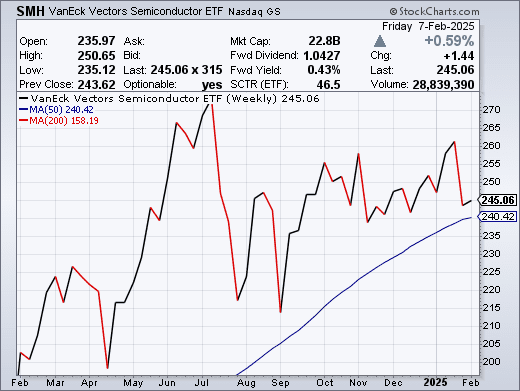
Chart courtesy of www.StockCharts.com.
Dividend Funds Ripe to Rebound from Semiconductor Slide: SOXQ
For investors who want to invest in the traditional Philadelphia stock exchange semiconductor index, known as the SOX, can buy Invesco PHLX Semiconductor (SOXQ), Carlson counseled. There are no surprises, since the index is well-established, Carlson added.
The index consists of the 30 largest semiconductor companies listed in the United States, he added. The index is weighted using a modified capitalization method. Recently, 61% of the fund was in the 10 largest positions.
Top holdings recently were Broadcom, NVIDIA, Advanced Micro Devices (NASDAQ: AMD), Marvel Technology (NASDAQ: MRVL) and KLA Corp. (NASDAQ: KLAC). SOXQ gained 2.27% so far in 2025 and 18.10% over the last 12 months. The dividend yield most recently reached 0.68%, Carlson said.
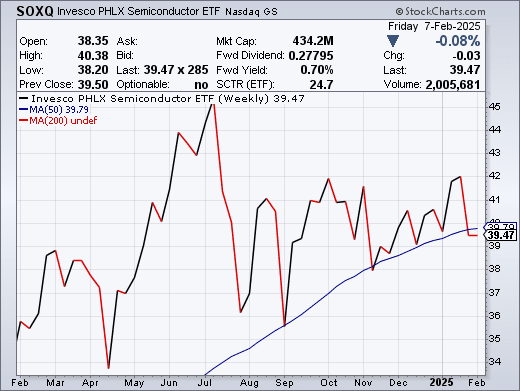
Chart courtesy of www.StockCharts.com.
Irving, California-based Broadcom Inc. is a current recommendation of technology futurist George Gilder in his Gilder’s Technology Report investment newsletter. The semiconductor company that makes products for wireless and broadband communications companies also is rated as a BofA Global Research buy and has received a $250 price objective from the investment firm.

Paul Dykewicz poses with George Gilder, who heads Gilder’s Technology Report.
Dividend Funds Ripe to Rebound from Semiconductor Slide: PSI
Investors looking for somewhat more actively managed exchange-traded funds (ETFs) can consider Invesco Semiconductors (PSI), said Carlson, of the Retirement Watch investment newsletter. That fund tracks the Dynamic Semiconductor Intellidex Index, which evaluates semiconductor stocks based on a range of factors and is reconstituted quarterly.
The fund typically holds 30 stocks, Carlson counseled. Recently, the 10 largest positions were 46% of the fund, he added.
Top positions in the fund were Broadcom, LAM Research (NASDAQ: LRCX), Applied Materials (NASDAQ: AMAT), NVIDIA and Qualcomm. The dividend yield recently was 0.68%. The fund gained 4.85% so far in 2025 and 22.22% during the last 12 months.
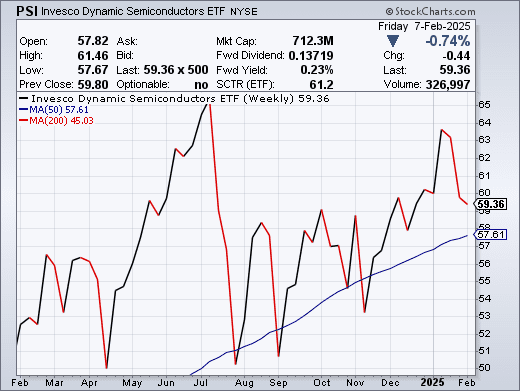
Chart courtesy of www.StockCharts.com
Dividend Funds Ripe to Rebound from Semiconductor Slide: FTXL
Another actively managed ETF for investors to consider is First Trust Nasdaq Semiconductor (FTXL).
FTXL tracks the Nasdaq US Smart Semiconductor Index and Carlson told me he monitors the fund. The index uses three factors to rank semiconductor stocks, relying heavily on momentum of the stock prices, as well as gross income and return on assets of the companies.
The index is reconstituted semiannually and recently held 31 stocks, and 64% of the fund was in its 10 largest positions. Top holdings recently were Broadcom, NVIDIA, Qualcomm, Applied Materials and Intel (NASDAQ: INTC. FTXL has a recent dividend yield of 0.68%. The fund is up 1.65% for the year to date and 9.78% over 12 months.
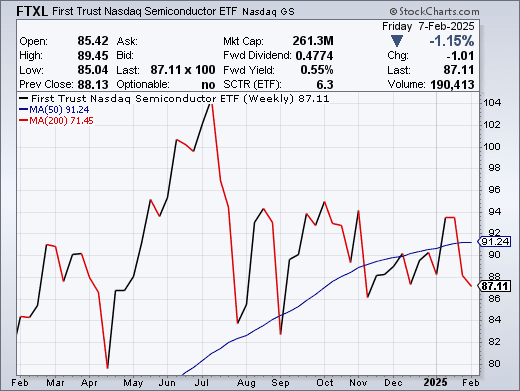
Chart courtesy of www.StockCharts.com
Dividend Funds Ripe to Rebound from Semiconductor Slide: XSD
A much different strategy aimed at delivering alternative returns and volatility is presented by SPDR S&P Semiconductor (XSD), Carlson continued. The fund tracks the S&P Semiconductor Select Industry Index, which comprises the semiconductors segment of the S&P Total Market Index, added Carlson, who also is the inventor of his proprietary IRA Calculator that helps investors figure out whether they should convert IRAs into Roth IRAs to reduce taxes.
The index gives the fund more stocks and less concentration than the others, Carlson opined. Smaller and mid-size companies also are more prevalent in this fund.
The fund recently held 41 stocks, with 34% of the fund invested in its 10 largest positions. Top holdings recently were Broadcom, Qorvo (NASDAQ: QRVO), Rambus Inc. (NASDAQ: RMBS), Credo Technology Group (NASDAQ: CRDO) and Allegro Microsystems Inc. (NASDAQ: ALGM).
The recent dividend yield was 0.73%. The fund has dipped a modest 0.61% so far in 2025 but soared 17.55% during the past 12 months.
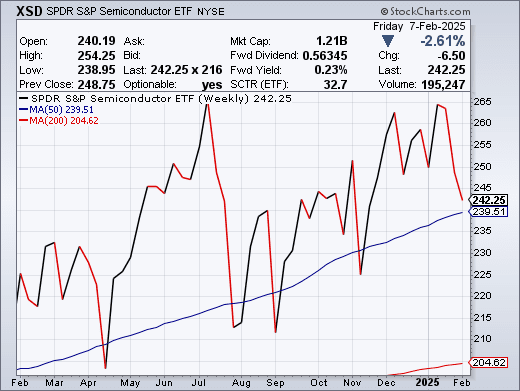
Chart courtesy of www.StockCharts.com.
Dividend Funds Ripe to Rebound from Semiconductor Slide:
As AI and other technology advances emerge, semiconductor stocks and ETFs give investors routes to attain rewards. Whether from space missions and satellites above the earth or AI applications on the ground, technology progress exhibited by gains in dividend funds ripe to rebound from a semiconductor slide offer ways for investors to pursue powerful potential profits.
Paul Dykewicz is the editor of StockInvestor.com and the editorial director of Eagle Financial Publications in Washington, D.C. He writes and edits for the website, as well as edits investment newsletters, time-sensitive trading alerts and other reports published by Eagle. He also is an accomplished, award-winning journalist who has written for Dow Jones, USA Today and other publications, as well as served as business editor of a daily newspaper in Baltimore. In addition, Paul is the author of the inspirational book, “Holy Smokes! Golden Guidance from Notre Dame’s Championship Chaplain.” He received his MBA in finance from Johns Hopkins University, where he was a two-time president of the school’s Finance Club. In addition, Paul has a bachelor’s degree from the University of Michigan and a master’s degree in journalism from Michigan State University. Outside of work, Paul volunteers with a faith-based organization to assist the poor in Southeast Washington, D.C., to learn personal finance skills to lift themselves out of debt.



